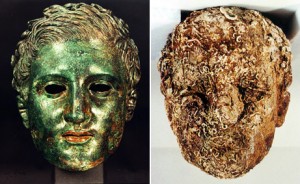A 1st c. BC Green statue found off the coast of Croatia in 1998 may provide scientists with new ways to combat biofouling, the accumulation of barnacles and other hull encrustations that damage ships.
The statue of an athlete (serendipitously posed scraping himself with a strigil) was found covered with biomineralizing organisms, creatures like barnacles that create their own shells from ingesting whatever they’re stuck on.
Croatian scientists restoring the statue said that the once crusty athlete can offer clues to how marine organisms absorb metals to form minerals for their shells.
Even creatures not in direct contact with the figure’s surface took up some of its metals, Medakovic’s team noted in their study.
What’s more, the study has shown the huge impact and disruption that this metal uptake had on the organisms’ metabolic pathways, and that caused the distressed organisms to produce untypical minerals in their shells, Medakovic said.
Living on a steady diet of copper and tin, the organisms on the statue had digested the metals to produce shells with unusual ratios of magnesium calcite and aragonite, for example, as well as traces of feldspar and quartz.
Scientists are hoping that by finding out exactly which metals caused which reactions in the beasties, they can develop metals that are more resistant to biofouling.
And now, the moment we’ve all been waiting for, the before and after pics:

On the left is Apoxyomenos’ head after the crusties were removed, on the right is his encrusted head.
His lips are that beautiful shade of red because they were made out of pure tin which turns red when oxidized, just like bronze oxidizes green because of its high copper content.